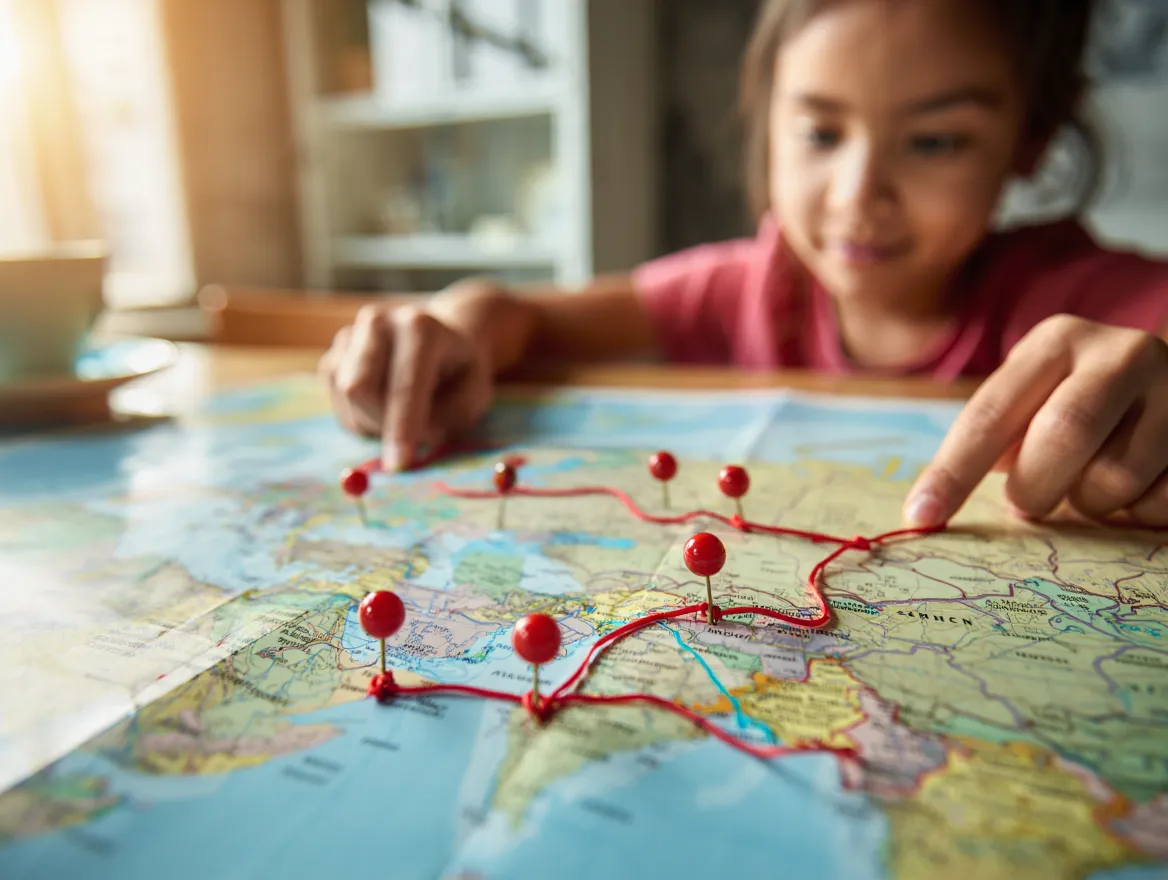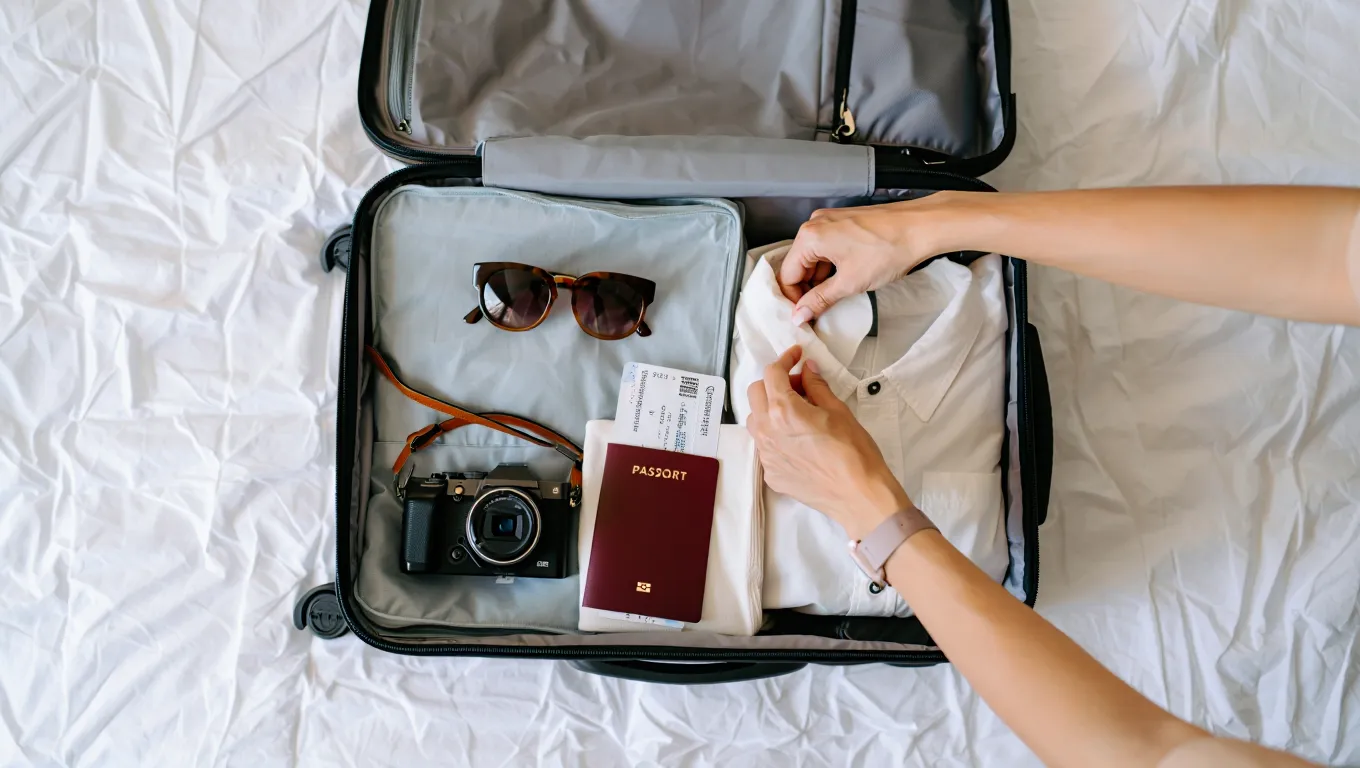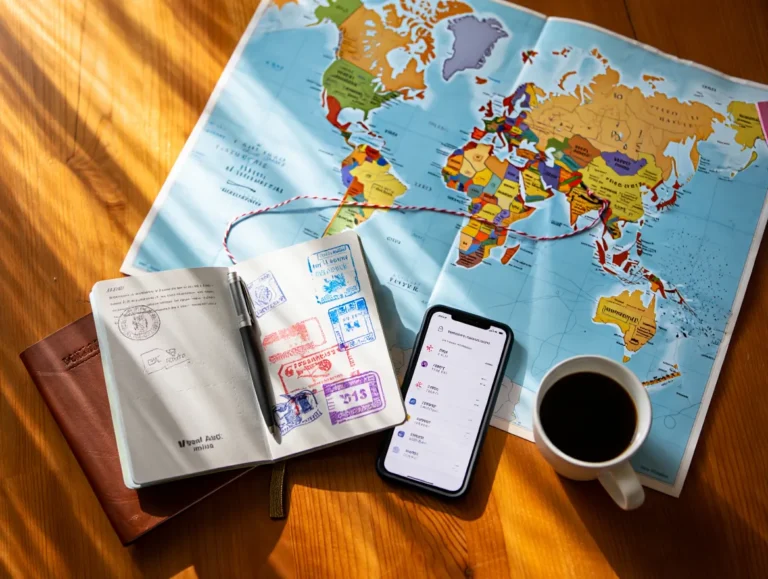On This Page
The thought of your first international trip is electrifying. It’s a cocktail of excitement, anticipation, and, let’s be honest, a little bit of anxiety. The idea of navigating a new culture, language, and currency can feel daunting. The secret to transforming that anxiety into pure excitement is simple: a solid plan. A well-organized approach takes the guesswork out of the process, ensuring you don’t overlook a critical detail like a visa requirement or an expiring passport.
This is not just another list of tips; this is your definitive 10-step guide. We have structured this comprehensive planning checklist into a clear, chronological timeline, starting a year before you travel all the way to departure day. By following these steps, you’ll tackle every essential task at the right time, making the planning for your first international trip as enjoyable as the journey itself.

The 10-Step Checklist for Your First International Trip
Think of this timeline as your roadmap. Tackling these tasks in order will prevent last-minute scrambles and ensure a smooth, well-prepared adventure.
Step 1: 6-12 Months Out — Passports & Visas
This is the absolute, non-negotiable first step. Before you book a single flight or hotel, you must verify your travel documents. Many countries require your passport to be valid for at least six months after your planned departure date from their country. If your passport is nearing expiration, renew it immediately. Standard processing times can be several months.
Next, research visa requirements for your potential destinations. Some countries offer visa-free travel for certain nationalities, while others require a visa that you must apply for weeks or even months in advance. The U.S. Department of State’s International Travel page is an excellent, authoritative resource to check country-specific requirements. Getting this done first is the most critical part of your planning checklist.
Step 2: 4-6 Months Out — Destination & Budget
With your passport in hand, the fun begins. Start by choosing a destination that is well-suited for a first international trip. Countries with a strong tourism infrastructure, where English is commonly spoken, can be great starting points (think Portugal, Ireland, or parts of Southeast Asia like Thailand). Consider factors like flight time, budget, and your travel style—are you looking for relaxation on a beach or a bustling city adventure?
Once you have a destination in mind, establish a realistic budget. Your budget will influence every other decision. Factor in major costs like flights, accommodation, food, activities, and a buffer for unexpected expenses. A well-planned budget is the financial foundation of a stress-free trip.
Step 3: 3-5 Months Out — Book Flights & Major Accommodation
This is often the sweet spot for booking international flights to get a good balance of price and availability. Use tools to track flight prices, and if you have flexible points, compare the cost of a cash ticket versus an award booking. For more on this, check out our beginner’s guide to booking flights with points.
Once your flights are booked, secure your primary accommodation. For your first international trip, booking your first few nights in advance provides a sense of security. You don’t have to plan every single night, but knowing you have a place to land upon arrival is a huge relief.
Step 4: 2-3 Months Out — Outline Your Itinerary
Now you can start sketching out a rough day-by-day itinerary. You don’t need to schedule every minute, but you should have a general idea of the main cities or regions you’ll visit and the key attractions you want to see. For highly popular tours or sites (like the Anne Frank House in Amsterdam or Alcatraz in San Francisco), you often need to book tickets months in advance. Researching and booking these key activities now will prevent disappointment later.
Step 5: 1-2 Months Out — Health & Safety
First, check with your doctor or a travel clinic about any recommended vaccinations or medications for your destination. The CDC’s Travelers’ Health website is an invaluable resource. Next, purchase travel insurance. This is a crucial step for any first international trip. Travel insurance can protect you from unforeseen events like trip cancellations, medical emergencies, or lost luggage. Finally, enroll in the Smart Traveler Enrollment Program (STEP) if you’re a U.S. citizen. This free service allows the U.S. Embassy to notify you in case of an emergency.
Step 6: 1 Month Out — Manage Your Money
Inform your bank and credit card companies of your travel dates and destinations to prevent them from flagging your overseas transactions as fraudulent. This is also a good time to ensure you have a credit card with no foreign transaction fees, which can save you a significant amount of money. See our review of the best credit cards for travel. Consider getting a small amount of foreign currency from your local bank before you leave, so you have cash on hand for immediate expenses like a taxi upon arrival.
Step 7: 2 Weeks Out — Get Connected & Pack Smart

Figure out your mobile phone situation. Relying on public Wi-Fi can be insecure and inconvenient. Consider purchasing an international data plan from your carrier or, for a more affordable and flexible option, an eSIM. An eSIM can be downloaded to your phone and activated upon arrival, giving you instant data access.
Start your packing list now. Check the weather forecast for your destination and pack accordingly. A great tip for your first international trip is to pack versatile layers. Lay out everything you think you need, then try to cut it by a third. Remember to leave some space for souvenirs.
Step 8: 1 Week Out — Organize Your Documents
This step is a cornerstone of a solid planning checklist. Gather all your important documents and create both digital and physical copies. This includes:
- Passport and any necessary visas
- Flight tickets and boarding passes
- Hotel and tour confirmations
- A copy of your travel insurance policy
- A list of emergency contacts
Save the digital copies to a secure cloud service (like Google Drive or Dropbox) and keep the physical copies separate from the originals in your luggage.
Step 9: 2-3 Days Out — Final Preparations
Confirm your flight status and check in online if possible. Download offline maps of your destination using Google Maps—this is a lifesaver when you don’t have a data connection. Download any movies, music, or podcasts for the flight. Charge all your electronics and pack your chargers and a portable power bank. Do your final packing and weigh your luggage to ensure it meets airline requirements.
Step 10: Departure Day — The Final Check
Before you walk out the door, run through a final quick check. Do you have your passport? Your wallet? Your phone? Are all the windows closed and appliances turned off? Give yourself plenty of time to get to the airport—for an international flight, arriving 3 hours early is recommended. Now, take a deep breath. You’ve done the planning. The adventure begins!
Gotchas You Shouldn’t Ignore
- Assuming Your Passport is Fine: The single biggest mistake is not checking your passport’s expiration date. The “six-month validity rule” is real and can result in you being denied boarding.
- Overpacking: First-time travelers almost always pack too much. Dragging a heavy suitcase over cobblestone streets is not a fun travel memory. Pack light and plan to do laundry if needed.
- Ignoring Local Customs: A little research into local etiquette, dress codes (especially for religious sites), and tipping customs goes a long way in showing respect and having a smoother experience.
- Relying on Your Home Bank Card: Using a debit or credit card with high foreign transaction fees can add hundreds of dollars to your trip cost. Get a travel-friendly card.
- Not Having a Backup Plan: Keep copies of your documents and have a backup credit card stored separately. If your wallet gets lost or stolen, you’ll be incredibly grateful you did.
How We Picked
This 10-step planning checklist was developed by consolidating decades of collective international travel experience into a logical, stress-free framework. We didn’t just create a random list of tasks; we structured it chronologically to align with a realistic planning timeline. Our methodology focused on:
- Prioritizing Critical Path Items: We placed tasks that have long lead times and can derail a trip (like passports and visas) at the very beginning.
- Reducing Cognitive Load: By breaking down the complex process of planning a first international trip into ten manageable stages, we aim to reduce the feeling of being overwhelmed.
- Focusing on High-Impact Actions: Each step is designed to address a critical area that, if overlooked, could lead to significant stress or expense, such as travel insurance, currency management, and document organization.
The result is a battle-tested roadmap designed to empower first-time travelers to plan with confidence and expertise.
FAQ
What is the best and safest destination for a first international trip?
Destinations known for safety, strong tourism infrastructure, and widespread English are often recommended. Countries like Portugal, New Zealand, Ireland, Costa Rica, and Thailand are popular and excellent choices that offer a great mix of culture, nature, and ease of travel for beginners.
How much money should I save for my first international trip?
This varies wildly by destination and travel style. A good starting point for a mid-range, one-week trip to Europe is around $2,000 – $3,000 per person, including flights. For Southeast Asia, it could be closer to $1,500 – $2,500. The key is to research the average daily costs for your chosen destination and create a detailed budget.
Is travel insurance really necessary?
Absolutely. For a first international trip, it is essential. Your domestic health insurance likely won’t cover you abroad. Travel insurance provides a crucial safety net for medical emergencies, which can be astronomically expensive overseas, as well as for things like trip cancellations, lost baggage, and travel delays.
How do I handle currency exchange?
The best approach is a multi-pronged one. Arrive with a small amount of local currency obtained from your home bank. For larger amounts of cash, use an ATM at your destination for the best exchange rates (ensure your debit card has low international fees). For most purchases, use a credit card with no foreign transaction fees.


